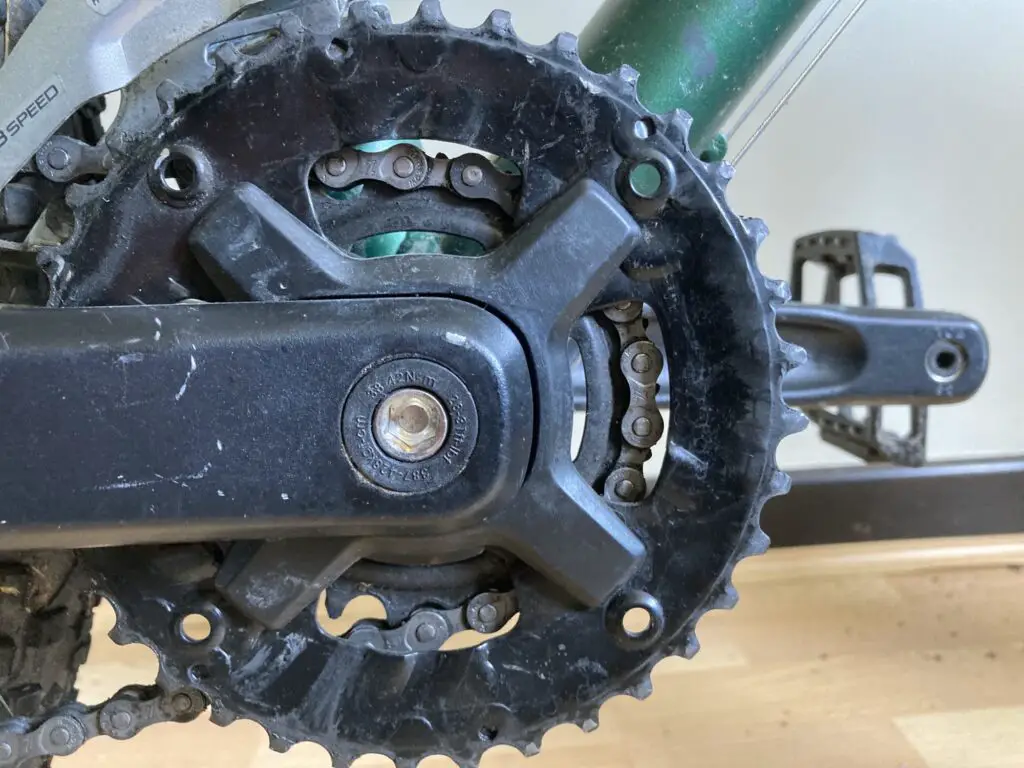Chainrings are an essential part of every drivetrain. They’re what transfers the power from the pedals to the rear wheel via the gears.
To keep your bike in top condition it’s worth knowing how long a chainring will usually last, and what to look for to decide when your chainring needs replacing.
How Long do Chaingrings Last on Average?
A mountain bike chainring will last between 1,500 miles up to 10,000 miles and above. A road bike chainring will typically last longer, often in excess of 50,000 miles provided the drivetrain is properly maintained.
Table of Contents

It’s difficult to give an exact figure for how long a chainring will last as it depends on a number of factors.
We’ll briefly discuss a few of those factors, then have a look at some data from a number of cyclists to see what the average lifespan of a chainring is.
Riders who are out on their bikes multiple times a week for a few hours at a time will go through more chainrings than somebody who rides much less.
The weather conditions in a specific area will also affect a chainrings lifespan, with wet and muddy conditions introducing more grit and grime into the drivetrain which will accelerate the wear on all of the components over time.
How well a bike is maintained is another factor at play. A bike that is thoroughly cleaned after every ride and has its chain replaced frequently will need replacement chainrings less frequently.
Additionally, how long a chainring will last varies between mountain bikes and road bikes due to the different conditions of each type of riding.
Let’s have a look at some data from mountain bikers and road cyclists when they were asked how long a chainring typically lasts.
How Long do MTB Chainrings Last?
A mountain bike chainring will last on average from 1,500 miles up to 10,000 miles and beyond. The number will vary based on the weather conditions a bike is exposed to. Frequent riding in wet and muddy conditions results in more wear on the chainring.
These numbers are a combination of discussions with mountain bikers and the average values stated by mountain bike riders across a number of forums.
It’s worth noting that those riders who responded with ‘over 10,000 miles’ indicated they’ve never had to replace a chainring on any of their bikes.
Whilst 1,500 miles was the lowest mileage to get any significant response, there were a small number of riders who claimed to need new chainrings every 1,000 miles or less.
In each of these cases, they admitted to not changing their chain frequently enough. Riding with a worn chain rapidly speeds up wear on the chainring.
It’s also important to consider chainring material. Those using aluminum chainrings reported needing to replace them more often than those using steel chainrings due to aluminum being a much softer metal.
How Long do Road Bike Chainrings Last?
A road bike chainring can last in excess of 50,000 miles. That’s equivalent to them lasting a lifetime for the majority of cyclists. The main reason a chainring would require replacement any more frequently than this is poor drivetrain maintenance, such as replacing the chain too infrequently.
How Often Should Chainrings be Replaced?
Chainrings should only be replaced when they are damaged or worn. Typically the chainring will last longer than the other major components of the drivetrain.
There’s no set timeframe for how often you should replace your chainring, however, it’s good practice to check over your chainring a few times per year, after any particularly long rides, or when you suspect you’ve hit the chainring on a rock or other obstacle.
Now let’s discuss how to tell when your chainring needs replacing.
How to Tell if a Chainring Needs Replacing
There are two main reasons a chainring can need replacing. The first reason is if the chainring has been damaged by an impact. This mostly occurs on mountain bikes when riding across rocky terrain that presents plenty of opportunities to strike the chainring.
To check if your chainring has been damaged first of all look for missing teeth. You can probably get away with a single tooth missing, however, if you manage to break off more than this you should replace the part.
Additionally, if your chainring is bent you should replace it as a bent chainring will mess up the tracking of your chain, makes pedaling less efficient, and will increase wear on the rest of your drivetrain.
The second main reason a chainring will require replacement is wear. The teeth of a worn chainring will be rounded off and uneven.
Left unchecked, the wear will increase over time to the point where your chain skips and even falls off altogether.
If you’re still unsure what to look out for to decide whether your chainring needs replacing or not, check out this video from Global Cycling Network. They cover a number of drivetrain components in the video, the chainring section starts at 2:20:
How to Make Chainring Last Longer
There are a number of steps you can take to extend the lifespan of your chainrings. Not only will the following tips save your chainrings, they’ll also help keep your entire drivetrain in good condition.
To make a chainring last as long as possible, stick to these guidelines:
- Properly maintain your drivetrain, including frequent oiling of the chain and chain replacement.
- Take care to avoid striking the chainring when you’re out on the trail.
- Use a steel chainring instead of aluminum.
- Keep your bike clean and your drivetrain free from dirt and mud.
- If your bike has multiple chainrings, make sure to change gears smoothly to avoid excessive strain on the chainrings.
